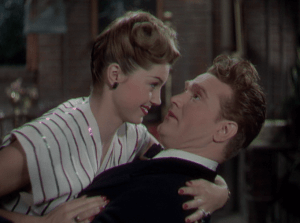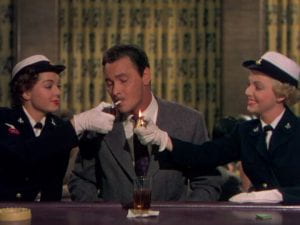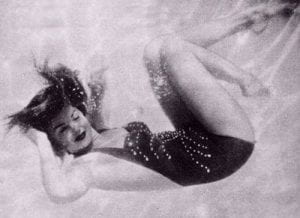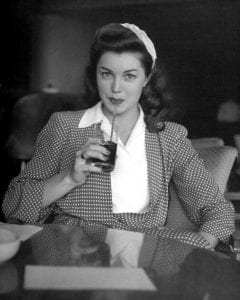
For the past eight years, I have been trying to explain the sheer joy that is Esther Jane Williams. From the moment I first laid eyes on the champion swimmer-turned-actress in Thrill of a Romance (1945), I was transfixed. As I sighed over her delicious chemistry with Van Johnson and marveled at the film’s Technicolor dreamscape, which enveloped my senses unlike anything else I had experienced from a film before, a million questions came into my head. Where did Esther and her films come from? How did such a unique star fit into classic Hollywood? Why did her swimming feel so empowering to me? And why wasn’t she someone whose career was better known? That last question is still something I think about all the time. Here was someone who broke records as a competitive swimmer, reluctantly came to Hollywood on her own terms, helped create a genre of swimming musicals that literally no one else could replicate, and became one of Hollywood’s brightest stars and yet she remains underrated and underdiscussed – a fate that I cannot bear to let happen, especially since August 8 will mark the centennial of this remarkable woman.
Esther was a striking and singular combination of the leggy pin-up, the dutiful mother and wife, the glamorous movie star, the shrewd businesswoman (whose swimsuit company is still going strong!), and the mesmerizing athlete. There is no denying what the main attraction is when watching an Esther Williams musical because every element is there to emphasize her and her persona as a resilient and ambitious woman. While that particular persona wasn’t hers alone — think Barbara Stanwyck, Bette Davis, or Katharine Hepburn — what sets Esther apart is her extraordinary prowess as an athlete.
She embodied a type of femininity where a woman could be physically strong without losing her desirability, her mobility, or her agency. Her co-stars seldom had as much clout at the box office as her, enabling her to take control of the film’s focus. With the exception of Fernando Lamas — who was a former competitive swimmer in Argentina — no leading man could keep up with Esther in the water, which helped to define the space as distinctively hers. The water reinforced her strength as it revealed her powerful body and highlighted her inimitable talent, substantiating Esther’s declaration that “it’s alright to be strong and feminine at the same time.”
“Strong and feminine” is an apt description for the way she swam in her films. When she joined Billy Rose’s Aquacade after her competitive career came to an end with the cancellation of the 1940 Olympics, Esther had to adjust from swimming fast to swimming “pretty.” While it looked effortless and graceful, she admitted that swimming pretty was deceptively difficult and physically demanding. Throughout her career, though, she demonstrated comfort with her body and delight with her swimming, which she believed was one reason why audiences loved her movies. Although her time in the water could be seen as spectacle or objectification, Esther presented her swimming as something that pleased her as well as her audience; you can ogle her body all you like, but the ownership of that body is hers.
Esther radiates a power that muddles the idea of the male gaze because she is so plainly in control of her body and how it is displayed. Part of that control lies in the unmistakable sexual desires of her characters. In Bathing Beauty (1944), when she finds herself newly reconciled with husband Red Skelton, she has him carry her over the threshold of his room and implies that she wants to be put on the bed by pointedly looking at it. Disappointed that he nervously put her on a desk instead, she moves onto his lap, stroking his hair and kissing him. Skirts Ahoy! (1952) is especially noteworthy because the main conflict between Esther’s character and Barry Sullivan’s is that she is the pursuer in the relationship and he can’t handle it.
Esther became a star at the beginning of WWII, a time when women were finding more freedom outside of the home. In her aquamusicals, the swimming of Esther’s characters was a representation of their autonomy; it gave them the ability to do what they wanted with their bodies and to feel good about it. In most cases, it also gave them an income and financial freedom that wasn’t tied up with a man’s as they supported themselves with livings as actresses, aqua stars, swimming instructors, swimsuit designers, and carnival performers.
Because she was the only aquamusical star, Esther is differentiated from the other female stars of her time and therefore emerges as someone who didn’t conform to the expected career of a Hollywood actress. This idea extends to her characters as well, such as the aquatic performers she played in Neptune’s Daughter (1949), Duchess of Idaho (1950), Million Dollar Mermaid (1952), and Easy to Love (1953); the dairy farmer-turned-English Channel swimmer of Dangerous When Wet (1953); and the baseball team owner of Take Me Out to the Ball Game (1949). There is also Fiesta’s (1947) aspiring bullfighter Maria, whose brother disappears after a family dispute and thus inspires her to impersonate him in the ring in the hopes that it’ll cause him to return. When Maria becomes injured by a bull in one of the last scenes, her nonconformity is seemingly punished, and yet Maria’s ability to accomplish what she set out to do — bullfight, find her brother, restore her family’s reputation, and marry her fiancé — regardless of the consequences can’t be ignored. Whether it be physical hardships, romantic complications, or even a threat to her life, Esther’s characters overcome whatever obstacles or consequences that arise and get the happy endings they want.
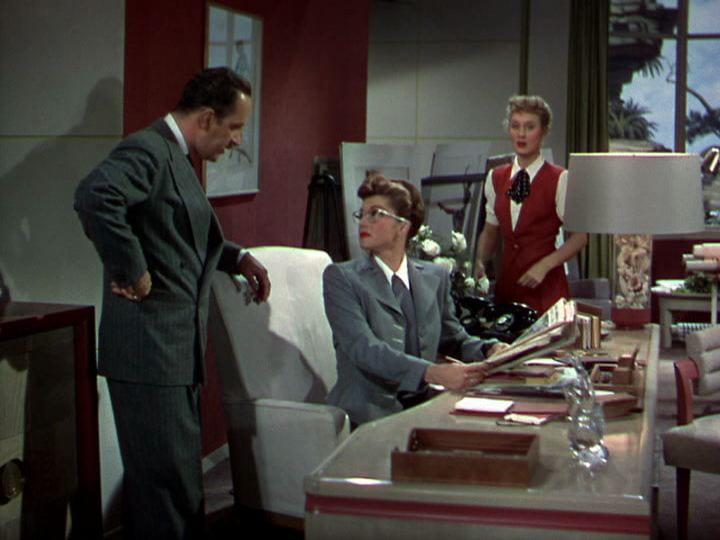
An Esther Williams character was never clumsy, ditzy, or bad at what they do. With her boldly executed stunts, like the dive in Million Dollar Mermaid that broke her neck, and her absolutely solid image of intelligence, confidence, and practicality, it wouldn’t have been believable if she had tried to play someone who was easily flustered or adorably naïve. Esther’s women voice their desires, freely move about any space they are in, and frequently stay career-driven, all while achieving professional and personal, specifically romantic, success. It wasn’t just Esther’s acting and athleticism that informed these characters, it was also her influence on her films’ screenplays. She would attend script meetings and had no qualms about jumping in with her own ideas, like the terrific conclusion to Dangerous When Wet’s climactic Channel race. One of her most important collaborators ended up being screenwriter Dorothy Kingsley, who welcomed Esther’s revisions and often included details in her scripts that were directly inspired by Esther’s life.
It would be a mistake to think that because the aquamusicals are escapist fare they don’t deserve serious attention. Esther may not have had the dramatic chops or the wide-ranging career of actresses like Greer Garson or Myrna Loy, but her presence and her swimming are still cathartically sublime for women. As Diane Sawyer said upon Esther’s passing in 2013, she was “a pioneer for a lot of little girls who knew strength and daring when they saw it.” Off the screen, she was just as groundbreaking by competing in races with a butterfly stroke that was only taught to men; challenging the Olympics to get synchronized swimming recognized as a legitimate sport in the ’80s; developing many successful business ventures, which attracted sexism and resentment from the media (after all, how could such a pretty girl be smart enough to handle business?); and fighting MGM head L.B. Mayer to become one of the first stars to receive an independent income from endorsements. Esther disrupted notions of what an actress could be, what a genre like the musical could do, and what female entrepreneurship could look like. She represented what women could be and what they already were.
She was so unapologetic in her ambition and her power, but she was also just a magical human being. She loved swearing and could talk for hours. She was terribly nearsighted, which made her fear that people would think she was snubbing them when the reality was she couldn’t make out who they were. She was perpetually late to everything, even her second wedding. After experiencing constant cruelty from director Richard Thorpe on several films, she used her newly gained influence to make sure he never directed her again; a few years later, she threatened to have another director, Sidney Lanfield, removed from Skirts Ahoy! because of his bullying of her co-star Vivian Blaine. By the end of her long life, Esther survived mental abuse, sexual assault, professional betrayals, a misogynistic industry, and personal heartbreak. Not a day goes by that I’m not in awe of this woman. Studying her career and watching her dazzling work has brought more to my life than I ever expected, and after eight years it feels like there is still so much to uncover and explore. I don’t know if I’ll ever be able to write the right words to express my love for this woman, but when someone has changed your life, maybe those words never come. For now, though, I think I’ll keep trying.
Easy to Love was screened at IU Cinema last March as my selection for the Staff Selects series.
I previously discussed Esther and Dangerous When Wet as part of June’s Monthly Movie Round-Up virtual event, which you can watch on the Cinema’s YouTube channel.

Michaela Owens is thrilled to be the editor of A Place for Film, in addition to being IU Cinema’s Publications Editor. An IU graduate with a BA in Communication and Culture and an MA in Cinema and Media Studies, she has also been a volunteer usher at IU Cinema since 2016. She never stops thinking about classic Hollywood, thanks to her mother’s introduction to it, and she likes to believe she is an expert on Katharine Hepburn and Esther Williams.



